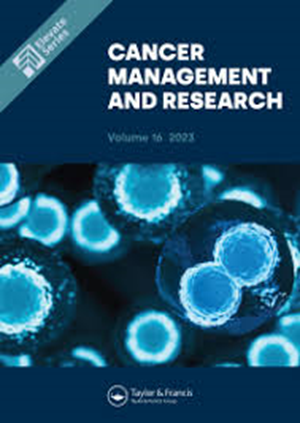利用泛免疫炎症值结合 PILE 评分构建用于晚期 NSCLC 免疫疗法预测预后的提名图
IF 2.6
4区 医学
Q3 ONCOLOGY
引用次数: 0
摘要
目的:本研究旨在探讨泛免疫炎症值(PIV)结合PILE评分对晚期非小细胞肺癌(NSCLC)患者免疫治疗的预测价值,并构建提名图预测模型,为临床工作提供参考:选取2019年1月至2021年12月在青岛市立医院接受ICIs治疗的晚期NSCLC患者作为研究对象。采用卡普兰-梅耶生存分析、Cox比例风险回归分析进行预后评估。结果通过提名图直观显示,并通过受试者工作特征曲线下面积(AUC)和C指数等指标判断模型的性能。根据 PILE 评分将患者分为高危和低危两组,并对不同风险组患者的预后进行评估:多变量Cox回归分析显示,免疫相关不良事件(irAEs)是总生存期(OS)改善的预后因素,ECOG PS评分≥2分、治疗前骨转移和PIV高表达是OS的独立危险因素。提名图模型预测 OS 的 C 指数为 0.750(95% CI:0.677- 0.823),校准曲线和 ROC 曲线显示该模型具有良好的预测性能。与低风险组相比,PILE 高风险组患者的炎症程度更高,身体状况更差,往往预后更差:PIV可作为接受ICIs治疗的晚期NSCLC患者的预后指标,并可构建提名图预测模型来评估患者的生存预测,从而有助于更好地进行临床决策和预后评估。 关键词:非小细胞肺癌;免疫检查点抑制剂;泛免疫炎症值;预后;提名图本文章由计算机程序翻译,如有差异,请以英文原文为准。
The Construction of a Nomogram Using the Pan-Immune-Inflammation Value Combined with a PILE Score for Immunotherapy Prediction Prognosis in Advanced NSCLC
Purpose: The purpose of this study was to investigate the predictive value of Pan-Immune-Inflammation Value (PIV) combined with the PILE score for immunotherapy in patients with advanced non-small cell lung cancer (NSCLC) and to construct a nomogram prediction model to provide reference for clinical work.
Patients and Methods: Patients with advanced NSCLC who received ICIs treatment in Qingdao Municipal Hospital from January 2019 to December 2021 were selected as the study subjects. The chi-square test, Kaplan-Meier survival analysis, and Cox proportional risk regression analysis were used to evaluate the prognosis. The results were visualized by a nomogram, and the performance of the model was judged by indicators such as the area under the subject operating characteristic curve (AUC) and C-index. The patients were divided into high- and low-risk groups by PILE score, and the prognosis of patients in different risk groups was evaluated.
Results: Multivariate Cox regression analysis showed that immune-related adverse events (irAEs) were prognostic factors for overall survival (OS) improvement, and ECOG PS score ≥ 2, bone metastases before treatment, and high PIV expression were independent risk factors for OS. The C index of OS predicted by the nomogram model is 0.750 (95% CI: 0.677– 0.823), and the Calibration and ROC curves show that the model has good prediction performance. Compared with the low-risk group, patients in the high-risk group of PILE were associated with a higher inflammatory state and poorer physical condition, which often resulted in a poorer prognosis.
Conclusion: PIV can be used as a prognostic indicator for patients with advanced NSCLC treated with ICIs, and a nomogram prediction model can be constructed to evaluate the survival prediction of patients, thus contributing to better clinical decision-making and prognosis assessment.
Keywords: non-small cell lung cancer, immune checkpoint inhibitors, pan-immune-inflammation value, prognosis, nomogram
Patients and Methods: Patients with advanced NSCLC who received ICIs treatment in Qingdao Municipal Hospital from January 2019 to December 2021 were selected as the study subjects. The chi-square test, Kaplan-Meier survival analysis, and Cox proportional risk regression analysis were used to evaluate the prognosis. The results were visualized by a nomogram, and the performance of the model was judged by indicators such as the area under the subject operating characteristic curve (AUC) and C-index. The patients were divided into high- and low-risk groups by PILE score, and the prognosis of patients in different risk groups was evaluated.
Results: Multivariate Cox regression analysis showed that immune-related adverse events (irAEs) were prognostic factors for overall survival (OS) improvement, and ECOG PS score ≥ 2, bone metastases before treatment, and high PIV expression were independent risk factors for OS. The C index of OS predicted by the nomogram model is 0.750 (95% CI: 0.677– 0.823), and the Calibration and ROC curves show that the model has good prediction performance. Compared with the low-risk group, patients in the high-risk group of PILE were associated with a higher inflammatory state and poorer physical condition, which often resulted in a poorer prognosis.
Conclusion: PIV can be used as a prognostic indicator for patients with advanced NSCLC treated with ICIs, and a nomogram prediction model can be constructed to evaluate the survival prediction of patients, thus contributing to better clinical decision-making and prognosis assessment.
Keywords: non-small cell lung cancer, immune checkpoint inhibitors, pan-immune-inflammation value, prognosis, nomogram
求助全文
通过发布文献求助,成功后即可免费获取论文全文。
去求助
来源期刊

Cancer Management and Research
Medicine-Oncology
CiteScore
7.40
自引率
0.00%
发文量
448
审稿时长
16 weeks
期刊介绍:
Cancer Management and Research is an international, peer reviewed, open access journal focusing on cancer research and the optimal use of preventative and integrated treatment interventions to achieve improved outcomes, enhanced survival, and quality of life for cancer patients. Specific topics covered in the journal include:
◦Epidemiology, detection and screening
◦Cellular research and biomarkers
◦Identification of biotargets and agents with novel mechanisms of action
◦Optimal clinical use of existing anticancer agents, including combination therapies
◦Radiation and surgery
◦Palliative care
◦Patient adherence, quality of life, satisfaction
The journal welcomes submitted papers covering original research, basic science, clinical & epidemiological studies, reviews & evaluations, guidelines, expert opinion and commentary, and case series that shed novel insights on a disease or disease subtype.
 求助内容:
求助内容: 应助结果提醒方式:
应助结果提醒方式:


